25 Surprising Facts About the History of Recipes
Cooking, cuisine, and recipe tips are a great choice for digital
content. Examples such as personal post on a food-related forum, an article on a
professional website, and could be as simple as a recipe posted on
a social media site like Facebook. Professional websites continue to profit from
food-related topics by writing articles pertaining to food served at holidays, traditional
ethnic cuisine recipes and cooking methods, and diet/low-fat cooking remain as
the most popular subcategories. What is fascinating
about recipes and food is that everyone has their own, uniquely personal,
culinary experience. Online forums are full of users whose cooking skills vary
from novice to professional, and just about everyone has something interesting
to share.
Painting Depicting Early Oven Cooking by Millet (1854):
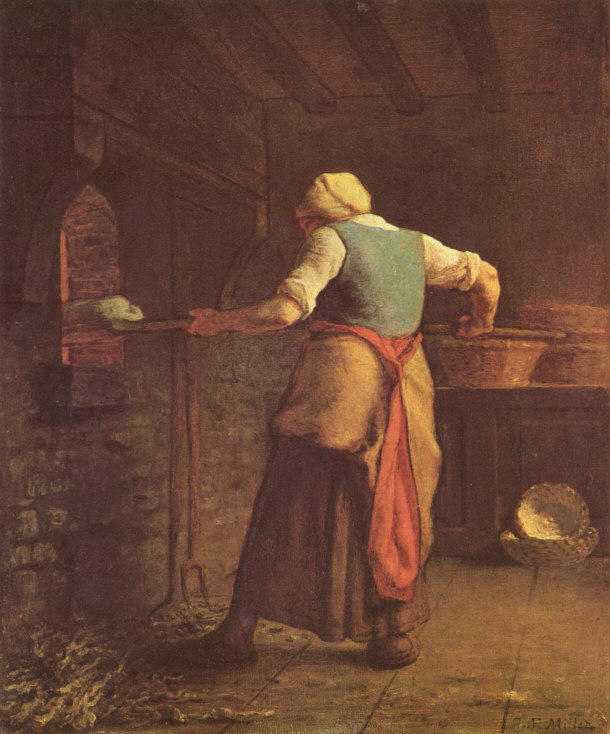
Thousands of years before people searched the Internet for recipes and years
before published cookbooks became readily available, recipes were passed on
through oral tradition. Oral tradition is when information is shared by one
generation with a younger generation by telling stories that typically had a
lesson or moral. This responsibility was reserved to whoever early communities
regarded as their holy man, priest, shaman, or in Kyrgyzstan what's called a Manaschi.
In Kyrgyzstan the Traditional Storyteller is Called a "Manaschi":

The geographical and cultural origin of many recipes and food traditions is
surprising. Pizza, a food most commonly thought of as a strictly Italian food
tradition, actually has a much more complex provenance that spans more than six
thousand years.
Authentic Pizza Margherita:

By ElfQrin
via Wikimedia Commons
Called "Pizza Margherita," the first pizza that is most characteristic
of what we order for delivery orders today, debuted in 1889 after Italy achieved
its complete independence from foreign control. The Pizza Margherita variety is
garnished with tomatoes, mozzarella cheese, and basil that was traditionally
reprehensive of Italy's national colors as well as economic conditions in late
nineteenth century Italy. Plagued with food shortages, Pizza Margherita calls
for a very short list of ingredients and were chosen because of they were
readily available to almost every Italian. Named after Queen Margherita of
Savoy, this style emerged victorious after something like a pizza cook-off was
commissioned by Queen Margherita who asked chefs from all over Italy to submit
their take on the dish.
Margherita of Savoy:

By পৰশমণি বড়া
via Wikimedia Commons
There are some who suggest that pizza's true origin dates back to the ancient
Greek, Persian, and Roman civilizations where bits of unleavened bread topped
with fish, spices, and oil providing easy meal solutions without needing a large
quantity of ingredients. What the Greeks, Persians, and Romans served mostly
resembles flatbread dishes offered by modern continental restaurants, and fall
quite short of most people's conception of pizza. Careful examination of pizza's
provenance strengthens the claim that the country most responsible for pizza is
Italy simply because its the simplest answer with the fewest discrepancies.
During the growth of western civilization, many traditional foods lost their
true heritage as the conquering nations/empires forced those they conquered to
assimilate. The Romans were notorious for adopting certain
traditions from their defeated foes. If the Romans liked a part of a conquered
peoples culture they would adopt it as their own, often making changes that suit
them in an attempt to make them their own. Pizza's story shows trying to arrive
at a singular origin for a dish can be difficult, often will be inaccurate as
certain historic details may have been unintentionally omitted, and never tells
the whole story. Many recipes are also older than you may suspect as food
movements cycle in and out of popularity. Here are some facts about the origins
of early recipes, traditional dishes, and other cool food facts.
25) The Bible Contains a Recipe
Recipes aren’t only found in cookbooks. You can find them in the Bible too. In
fact, a recipe is found in the 30th Chapter of Exodus detailing the amounts
of spice required for Tabernacle incense. Tabernacle is another word for altar. The recipe is also
mentioned in the Jewish Mishnah or "Oral Torah".
Illustration of Exodus Chapter 30, Verse 2 Depicting
Incense Burning on Tabernacle:

By
Distant Shores Media/Sweet Publishing
via Wikimedia Commons
Long before they were compiled and recorded by religious scribes, both the
Jewish Torah and Christianity's Bible began as simple stories that holy
men told to their followers. Prior to recorded or written language, this was the
only way that religion could be kept alive among the common people as most could
not read.
24) Britain’s Oldest Recipe is from 6000 BC
Declared to be Britain’s oldest recipe in 2007, nettle pudding dates all the way
back to 6000 BC. A nettle is a herbaceous plant with jagged leaves covered with
stinging hairs. A general recipe for traditional nettle pudding calls for nettles, dandelions, and sorrels
to be mixed with barley, water, and salt.
Nettle Pudding:
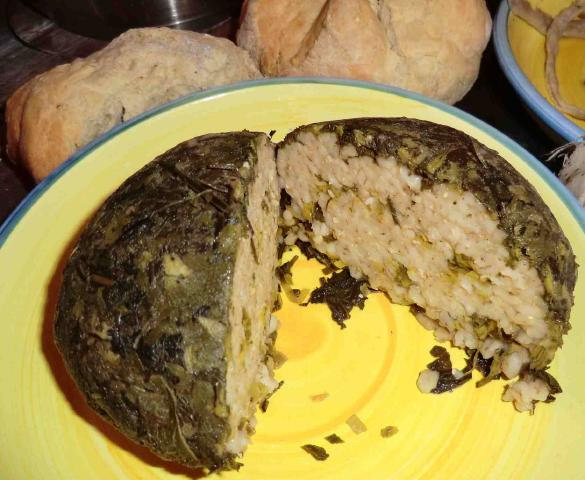
Another early English recipe, smoky stew or smoky lentil stew, has been
around almost as long as nettle pudding and serves as the culinary precursor to
haggis. Roast hedgehog served with cinnamon sauce or duck, is another recipe
that dates back to 6000 BC.
Smoky Lentil Stew:
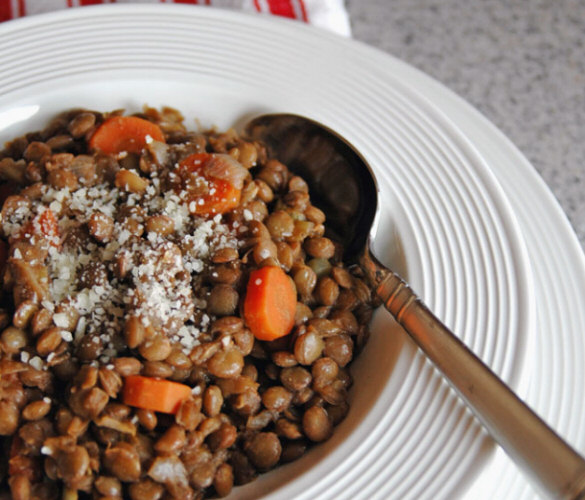
Unlike nettle pudding and smoky stew, the roast hedgehog dish was solely
reserved for the most rich and influential members of society. Below are two
recipes, one for traditional smoky fish stew and one for nettle pudding that are
consistent with prehistoric culinary craft. (Trouble reading? Click to Enlarge!)
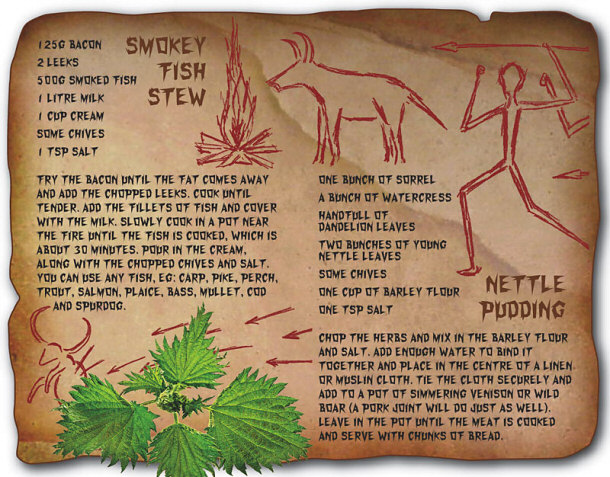
23) Ancient Romans Introduced Herbs to Western Cuisine
The Ancient Romans can be credited with influencing Western culture in one of
a number of areas, including the art of meal preparation.
Fresco Depicting Roman Family Feast (Prior to 79 AD):
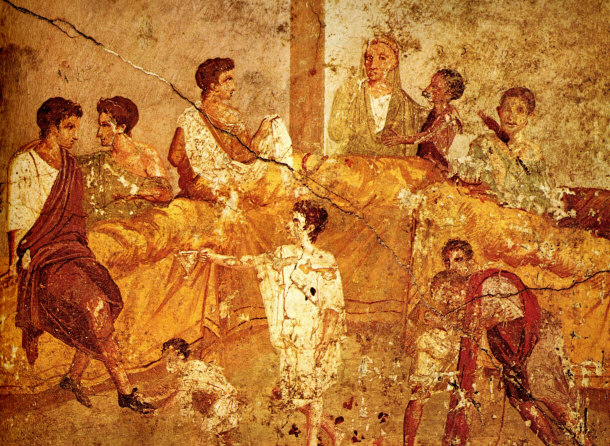
The civilization
frequently used herbs in their recipes, which are included in many recipes
today. Among the most popular additives were thyme, parsley, mint, pepper, fennel and
basil.
3 Silver Roman Piperatoria (Ancient Pepper Shakers) from
Roman Brittan:
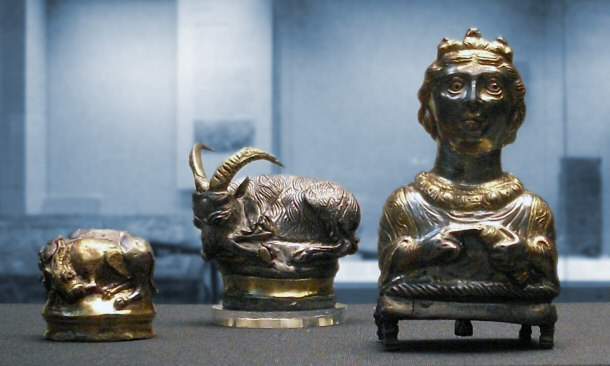
22) Recipes Were Once a Status Symbol of the Rich
Throughout the 16th and 17th centuries, noble households across Europe often
competed against each other to see who could be the most lavish or exclusive.
Recipes were included in this rivalry as well. Households tried to outdo one
another in an attempt to see who could collect the most extravagant recipes.
They even published their own recipe books in an attempt to show up their peers.
The origin of cooking books is also credited to the Romans and one of the most
notable comes from an ancient compilation known as the Apicius. The Apicius is a
collection of Roman cookery recipes compiled in the late 4th or early 5th
century AD.
Apicius Manuscript (ca. 900 AD) Belonging to the Monastery of Fulda in
Germany:
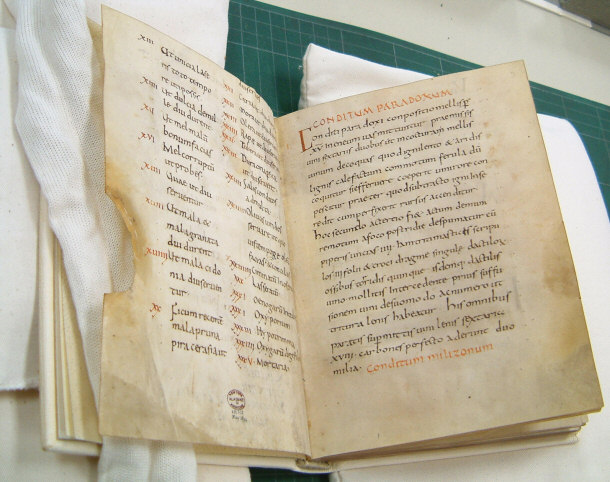
By Bonho1962
via Wikimedia Commons
The Apicius, which would be later entitled "On the Subject of Cooking", was
privately printed by Martin Lister in 1709.
Frontispiece of 2nd Edition of Lister's Apicius:
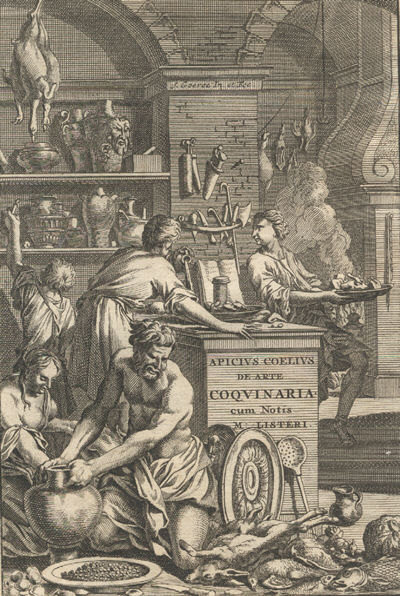
Inside Frontispiece of 2nd Edition of Lister's "On the
Subject of Cooking":
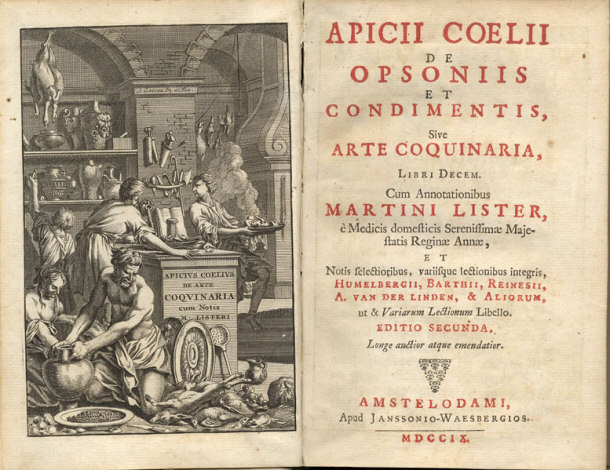
The source of this ancient publication was first put together as
a way to pay tribute to a man named Marcus Gavious Apicius. Marcus Gavious
Apicius was a renowned Roman gourmet and connoisseur of Roman luxury life.
Considered to be the authority on fashionable life in ancient Rome, the text
contains ten books arranged similarly to that of a modern cookbook. The sections
were titled Epimeles - The Careful Housekeeper, Sarcoptes - Te Meat Mincer,
Cepuros - The Gardener, Pandecter - Many Ingredients, Ospreon - Pulse, Aeropetes
- Birds, Polyteles - The Gourmet, Tetrapus - The Quadruped, Thalassa - The Sea,
Halieus - The Fisherman.
21) The Creator of the Chocolate Chip Cookie Exchanged the Recipe for
Chocolate
The history of the chocolate chip cookie dates back to the year 1939, when Ruth
Graves Wakefield serendipitously invented the treat and the brand "Toll House"
became a permanent household name. Wakefield and her husband
were operating a motel at the time called the Toll House Inn. Ruth, who often
cooked and experimented with recipes for her guests, especially favored a recipe
for butter drop do cookies.
Ruth Wakefield and the Legendary Toll House Inn:

One day, when the exploratory cook ran out of Baker's chocolate, she
alternatively tried a Nestle semi-sweet chocolate bar in her recipe for the
butter drop dos. However, the semi-sweet bar did not melt as easily as the
Baker’s chocolate and transformed the cookies into the first chocolate chip
variety.
Ingredients Using Premium Chocolate Instead of Nestle Chips:

By Daniel Case
via Wikimedia Commons
Eventually, Mrs. Wakefield reached an agreement with Nestle where she allowed
the chocolate company to print her recipe for chocolate chip cookies on the back
of their semi-sweet packages. In turn, the cook received an ongoing supply of
semi-sweet chocolate bars for life.
20) There’s an Open Source Recipe for a Coke Substitute
In 2001, the company OpenCola released an open source recipe that was listed
as an alternative to Coca-Cola. The recipe detailed all the necessary
ingredients and steps needed to make the drink. Anybody could access the recipe
and even change it completely for free. There was only one condition - that any
altered recipe had to be released to the public for free.

The company behind the idea had originally intended to use the recipe to
promote an open source software product which they had developed. However, the
OpenCola recipe proved to be far more interesting to consumers.
19) Recipes Can’t Be Copyrighted
While a collection of recipes can be copyrighted, a recipe itself cannot.
Even when a recipe book is copyrighted, the recipes themselves aren’t protected.
Only the way the recipe is presented—its layout, images, or commentary—is
safeguarded under copyright law.

However, a recipe is fully protected, with
respect to its ingredients, when it’s considered a trade secret and used
commercially.
18) There’s a Website Determined to Discover KFC’s Recipe
Since the 1930s, the fast food restaurant KFC has made a fortune with its
original recipe for fried chicken. For decades, people have been trying to
figure out what ingredients go into the preparation. In fact, there is actually
a website devoted to unearthing the famous recipe – one which KFC claims
consists of 11 secret herbs and spices.
KFC Location in Belfast, Ireland:

By Ardfern
via Wikimedia Commons
The site offers numerous tips and tricks to use in replicating the chicken
cuisine. However, despite the site’s popularity and its various suggestions, no
one has been able to determine what goes into KFC’s listing.
17) The Mayans Used Tomatoes in Recipes Long before the Italians
Tomatoes are a staple in Italian cooking. In fact, you might say that no
other culture has made such a remarkable and inventive use of the well-known
food. However, the Italians were not the first people to use the vegetable-like
fruit, nor were they the first culture to grow and harvest the plant. Tomatoes
actually originate from South America, where they were commonly used by the
Mayan civilization.
Map Showing Extent of Mayan Civilzation:

By Sémhur
via Wikimedia Commons
Therefore, the tomato did not reach Italian soil until the colonization of
the Americas by the Spanish. At that time, the food was shared with the rest of
the world. The Europeans referred to the tomato as a “golden apple” – a term
that was coined in 16th century European literature. At that time, tomatoes
looked similar to a yellow cherry tomato rather than the large red fruit of
today.
16) Coca-Cola Produced Coke That Looked Like Vodka
During the Cold War, when Russia, or the then Soviet Union, opposed America
and its capitalism, Coca-Cola, made by the U.S., was still a favorite drink.
Marshall George Zhukov of the Soviet Union particularly liked the beverage.
However, because of Soviet sentiment, he didn’t want to be seen in public
enjoying the soft drink, nor did he want to give it up.
Advertisement for Russian Stolichnaya Brand Vodka:

Ultimately, Zhukov asked Coca-Cola to make a version of Coke that looked like
Vodka. That way, he could drink the dark-colored drink in public without notice.
Coca-Cola complied by removing Coke’s caramel coloring, thereby making it clear.
The new version of the drink was appropriately referred to as “White Coke.”
15) Bubblegum Is Traditionally Pink by Chance
Back in 1928, while working as an employee of the Fleer Chewing Gum Company,
Walter Diemer produced a recipe that resulted in a type of bubblegum that was
more stretchy and significantly less sticky than standard bubblegum.

Despite his achievement, Diemer didn’t like the natural color of the product
so he added the only coloring that he immediately had on hand. The pink color he
included made bubblegum an instant success. Although the color was added by
chance, pink became associated with the product and has remained that way ever
since.
14) Some Recipe Instructions Can Be Harmful to One's Health
The harmless act of baking a potato in aluminum foil can have serious health
consequences. If a potato is baked and left at room temperature, you may
inadvertently establish an environment in which botulism (Clostridium Botulinum)
can thrive.

By Herbert L. Fred, MD and Hendrik A. van Dijk
via Wikimedia Commons
The microorganisms that cause botulism come from the soil where the potato is
grown. Usually, the cooking process will kill off the bacteria. However, when
the potato is wrapped in aluminum, the moisture in the vegetable is contained.
As a result, the heat may not reach a level that’s high enough to kill the
microorganisms in the vegetable.
13) Alcohol Can Still Remain in Foods after They are Cooked
Invariably, any recipe that uses alcohol will specify that most, if not all,
of the ingredient will disappear through the cooking process. However, the
percentage of alcohol that remains depends on one of a variety of factors,
including the cooking time.

Surprisingly, studies have found that, in many instances, alcohol remains in
cooked recipes. In fact, up to 85% of the original alcohol content will not be
cooked away, especially if the substance is added to a boiling liquid before it
is taken off the stove. Even when a food is cooked for two hours, about 5% of
the substance stays in the food. In order to remove the alcohol content in a
recipe then, the food has to simmer for a minimum of three hours.
12) Studies Show That Cooks Like their Recipes Better When They Are Prepared
by Someone Else
Scientific tests have determined that the meal you make for yourself will not
taste as good as when somebody prepares the same course, even if it is prepared
in the same way. That’s because the cook becomes desensitized to the smell when
he is preparing the cuisine. Because a major part of taste is related to smell,
the food won’t taste as good if you prepare it yourself.

So, if someone else cooks for you and prepares the meal in another room, your
first impression of the entrée will be enhanced. This scientific principle also
relates to leftovers. When the food is left in the fridge, the aroma that is
emitted when the food is heated will make the food taste especially good. That’s
why a lot of leftovers seem to taste better the following day after a meal has
been prepared.
11) The Original Ketchup Recipe Didn’t Contain Tomatoes
Ketchup, otherwise known as catsup, is perhaps the most identifiable sauce or
condiment in the world. Well-known for its sweet tomato flavor, the sauce, at
one time, did not contain any hint of a tomato at all.

Based on an old Chinese sauce, called ke-tsiap, from the 17th century, catsup
once was produced with pickle fish sauce, closely akin to today’s Worcestershire
sauce or soy sauce.
English sailors discovered ke-tsiap through their travels, which led to the
condiment’s eventual distribution throughout the world. Tomatoes weren’t added
to the recipe until the 1700s, when catsup was referred to as tomato soy sauce.
10) There’s a Restaurant That Makes Its Burgers and Fries with 100-Year-Old
Grease
Dyer's Burgers, which is located in the downtown section of Memphis on
historic Beale Street, has an unusual and surprisingly successful claim to fame.
While the burgers and fries reportedly taste great, it’s not what’s in them
but how they’re made that makes them remarkable. Basically, their recipe relies
on the special grease that the restaurant uses – a grease that has been used
time and time again.

The burger joint, which has been around for over a hundred years, claims that
it’s been using the same grease that it has always used since the first time it
opened its doors. The grease is strained every day to remove impurities, but has
never been nor, apparently, will ever be thrown out.
9) Oreos Are a Knock-Off Brand
Oreos are a brand of cookies that are recognized throughout the world. What
isn’t so well-known about the cookies is that they are a knock-off of a brand
known as Hydrox. Both cookies are small, circular cream-filled chocolate
sandwiches and are produced with the same basic recipe.
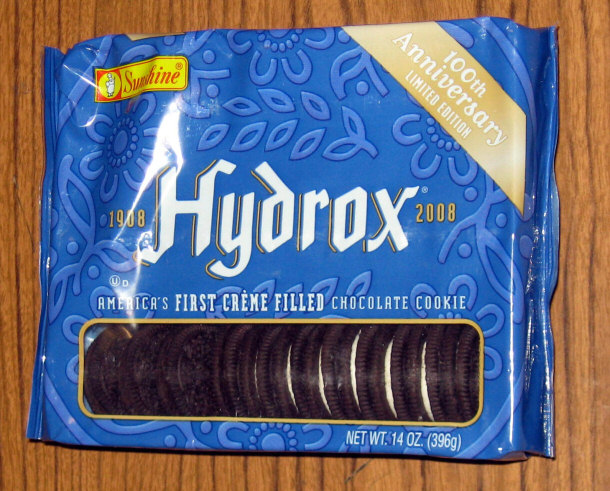
The Hydrox cookies were first produced by the company, Sunshine Biscuits, in
1908. Oreos hit the market a few years later and became a huge success – so much
so that many people thought that the Hydrox cookies were actually the knock-off
brand. Ultimately, people found that Oreos were better when paired with milk,
thus the cookies gained more acclaim.
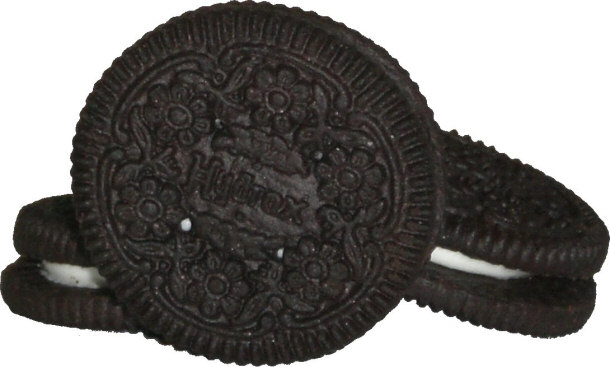
By Spacefem
via Wikimedia Commons
The Hydrox cookie remained on the market until the late 1990s, when it was
replaced with a similar cookie line named Droxies. The Carvel ice cream chain,
which sells ice cream products, currently manufactures their ice cream using
crumbs from the Hydrox brand. The cookie remnants, according to the company, are
unlike Oreos, as they are made with kosher ingredients, thereby suggesting that
the original recipe is still used.
8) Taking Something With a Grain of Salt Originates from an Ancient Roman
Recipe
Nowadays, to take something with a grain of salt means to regard a comment or
“fact” with skepticism, and not to necessarily believe what is being said. The
saying dates back to 77 BC, when it was originally featured in the book,
“Historia Naturalis,” as a recipe.
Title Page From 1669 Edition:

The book stated that an antidote for poison could be created when you
combined a grain of salt with two figs, two dried walnuts, and twenty leaves of
rue. The saying, which was derived from the recipe, was first coined in 1647 by
John Trapp, an English commentator of the Bible.
Hand-Printed Version by Johannes Alvisius in 1499 Venice, Italy:

By Bjoertvedt
via Wikimedia Commons
Both the modern and past interpretations relate to not putting a lot of
weight or stock on certain actions or words.
7) Strawberry Flavoring Consists of 50 Different Chemicals
Very few mass-produced products that are strawberry-flavored are actually
made from strawberries. Food manufacturers have long since developed a recipe
that mimics the taste of strawberries, which consists of 50 different types of
chemicals.

While developing a chemical concoction to produce an artificial flavor can be
expensive, once a recipe is perfected, it is significantly cheaper to mass
produce. Therefore, most food manufacturers have their own special recipes of
chemicals that go into their artificial flavorings. Strawberry flavoring is
often used in milkshakes or processed desserts.
6) The Hawaiian Pizza Recipe Has Nothing to Do with Hawaii
Other than the fact that pineapples grow in Hawaii, the Hawaiian pizza recipe
has absolutely nothing to do with the American state and island chain. The
recipe didn’t even originate from this country. The Hawaiian pizza’s history
dates back to 1962, when Greek-Canadian restaurant owner, Sam Panopolous,
created the unique pie, using pineapple, ham, cheese, and tomato sauce.

By Simplicius
via Wikimedia Commons
Featured at Panopolous’ restaurant in Chatham, Ontario, the Hawaiian cuisine
was much more popular than the other creation developed by restaurateur – the
Hawaiian hamburger.
5) The Original Recipe for the Oreo Filling Included Pork Fat
Oreo cookies are the most successful brand of cookies that have ever been
made. Over a half trillion cookies have been sold to consumers since the product
was introduced to the market in the early 20th century.
Different Sizes of Oreos Available:
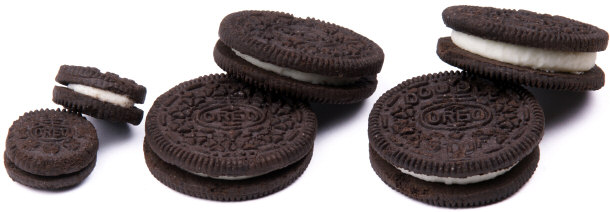
However, in earlier times, pork fat was added to the filling rather than
non-hydrogenated vegetable oil as it is today. What’s more, the pork-fat Oreo
featured a thick cream filling. However, since 1998, the cookies have been made
with a healthier concoction of ingredients, thanks to public pressure to alter
the recipe.
4) The Original Chocolate Milk Recipe Was Medicinal
Chocolate milk was invented by Irish physician, Sir Hans Sloane in 1687
during his travels in Jamaica. He had originally gone to the country to tend to
the Duke of Albemarle. However, when the Duke died, Sloane spent 15 months
making notes of approximately 800 new species of plants.
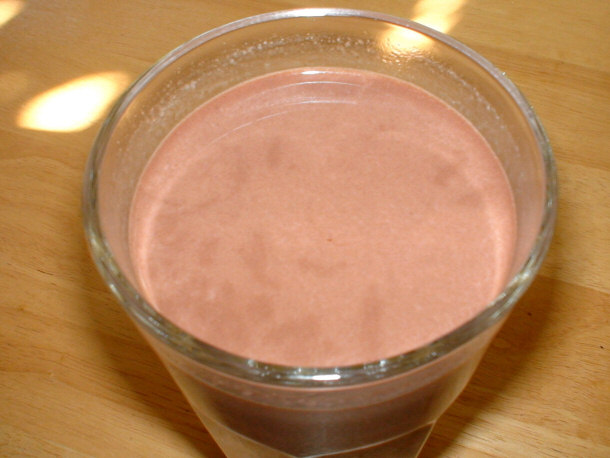
The most significant plant he made note of was the cacao plant, which
produces the cocoa bean. Sloane noted that locals drank cocoa beans mixed with
water. Because Sloane found the drink to be unpalatable, he tried mixing it with
milk, which he automatically liked. When he took his new cocoa recipe back to
England, it was originally sold as a medicine. However, people soon found out
that the substance made a better treat.
3) Thomas Jefferson Invented the Recipe for Mac and Cheese
Thomas Jefferson leant his influence to America in a variety of ways. Besides
being one of the nation’s Founding Fathers, serving as the country’s third
President, and drafting the Declaration of Independence, Jefferson also gave the
country macaroni and cheese.

By Stuart Spivack
via Wikimedia Commons
Actually, it’s unclear whether Jefferson invented the recipe or just played a
significant role in its development. However, what is clear is that Jefferson
and/or cookbook author, Mary Randolph, came up with the ingredients for the
entrée after Jefferson returned from a trip to Italy.
Mary Randolph authored the first cookbook in the U.S., called "The Virginia
House-wife," and was the first person buried in Arlington National Cemetery. Her
brother was the son-in-law of the President. Originally, the recipe was made of
macaroni and Parmesan cheese instead of macaroni and cheddar cheese as it is
today.
2) The Original Recipe for Peanut Butter Was Used As a Health Supplement
Peanut butter is perhaps the most famous spread throughout the world. The
origins of the spread date back to the Ancient Aztecs, who commonly produced a
peanut paste from a mash of nuts.
"Smooth" Peanut Butter in a Jar:

By Gene.arboit
via Wikimedia Commons
However, the basis for today’s recipe was patented by Dr. John Harvey Kellogg
in 1895. He initially used peanut butter as a health supplement for his patients
at the Battle Creek Sanitarium in Michigan. Despite Kellogg’s original
intentions, the product proved to be a popular treat during the first part of
the 20th century. In fact, it was primarily enjoyed by the wealthy as it was
quite expensive at the time.
Peanut butter became especially popular when Julia Davis created the recipe
for the peanut butter and jelly sandwich in 1901. During the period, the
sandwich was served in upscale tearooms. Happily, by 1920, the price of the
spread had dropped in price. Therefore, everyone could enjoy the peanuty treat.
1) The First Recipe for Ice Cream Dates Back to 400BC
Ice cream has been loved for generations. However, the history of ice cream
dates farther back than what most people might think. The earliest documentation
of ice cream goes back to the Persian Empire to the year 400 BC. At that time, people
combined fruit juice with snow in order to make the frozen dessert. They used
the shavings from the ice they retrieved from the mountain tops, and stored the
ice-snow in underground chambers called yakhchals.
Yakhchal in Yazd, Iran:

By Pastaitaken
via Wikimedia Commons
Interior of Yakhchal:

By User:Ggia
via Wikimedia Commons
Over time, ingredients, such as rose water, saffron and a variety of other
flavorings were added to the recipe. Ancient societies all had their recipes for
ice cream. For example, Alexander the Great consumed a mixture of honey and
nectar that was mixed with snow, and King Solomon and the Roman Emperor Nero
also enjoyed the treat. Ice cream gained further popularity when Marco Polo
obtained a recipe from his travels in the Far East.
Eventually, ice cream evolved into the dessert it is today, made with cream
or milk and various delicious flavorings. A Sicilian, named Procopio Cutò,
concocted a recipe made of cream, butter, milk, and eggs, which was served as
gelato at the first Paris café. Once a sorbet, the recipe eventually became the
milk-based product it is today.
Conclusion
Needless to say, many of the world’s favorite treats come from the
unlikeliest of places. In a world where many cultures center their activities on
food, we, no doubt, can look forward to the continual creation of new recipes
and dishes.
Recipes
25
Surprising Facts About the History of Recipes
|